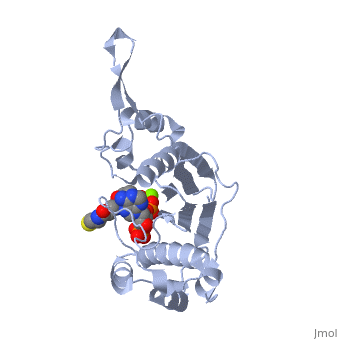Molecular Playground/4'-PHOSPHOPANTETHEINYL TRANSFERASE (Sfp): Difference between revisions
Jon Amoroso (talk | contribs) New page: == 4'-PHOSPHOPANTETHEINYL TRANSFERASE SFP == <StructureSection load='1qr0' size='350' side='right' caption='Structure of HMG-CoA reductase (PDB entry 1dq8)' scene=''> '''Sfp''' is a 4'... |
m Sfp moved to Molecular Playground/4'-PHOSPHOPANTETHEINYL TRANSFERASE (Sfp): make public |
||
| (9 intermediate revisions by 3 users not shown) | |||
| Line 1: | Line 1: | ||
== 4'-PHOSPHOPANTETHEINYL TRANSFERASE | == 4'-PHOSPHOPANTETHEINYL TRANSFERASE (Sfp) == | ||
<StructureSection load='1qr0' size='350' side='right' caption='Structure of HMG-CoA reductase (PDB entry [[1dq8]])' scene=''> | <StructureSection load='1qr0' size='350' side='right' caption='Structure of HMG-CoA reductase (PDB entry [[1dq8]])' scene=''> | ||
Sfp | == Introduction == | ||
'''Sfp''' is a 4'-phosphopantetheinyl (PPant) transferase endogenous to ''B. Subtilis'', first crystallized in 1999 [1]. The function of Sfp is to transfer a phosphopantetheinyl group from <scene name='Sfp/Coa_highlight/5'>coenzyme-A</scene> (CoA-SH) to the serine residue of peptides containing the sequence "DSL". Frequently this sequence is found in acyl- or peptidyl-carrier proteins in fatty acid synthases (FASs), polyketide synthases (PKSs), and nonribosomal peptide synthetases (NRPSs). This posttranslational modification converts the inactive apo form peptide to the active holo form. The terminal thiol PPant prosthetic group acts as a point of covalent attachment between the peptide and the growing fatty acid, polyketide, or nonribosomal peptide. | |||
== Mechanism of Transfer == | |||
<scene name='Sfp/Sfp_mg/6'>Active site magnesium</scene> along with ATP are involved in the catalytic transformation of the apo proteins. | |||
== Biochemical Applications == | |||
</StructureSection> | </StructureSection> | ||
Latest revision as of 00:22, 13 December 2012
4'-PHOSPHOPANTETHEINYL TRANSFERASE (Sfp)4'-PHOSPHOPANTETHEINYL TRANSFERASE (Sfp)
IntroductionSfp is a 4'-phosphopantetheinyl (PPant) transferase endogenous to B. Subtilis, first crystallized in 1999 [1]. The function of Sfp is to transfer a phosphopantetheinyl group from (CoA-SH) to the serine residue of peptides containing the sequence "DSL". Frequently this sequence is found in acyl- or peptidyl-carrier proteins in fatty acid synthases (FASs), polyketide synthases (PKSs), and nonribosomal peptide synthetases (NRPSs). This posttranslational modification converts the inactive apo form peptide to the active holo form. The terminal thiol PPant prosthetic group acts as a point of covalent attachment between the peptide and the growing fatty acid, polyketide, or nonribosomal peptide.
Mechanism of Transferalong with ATP are involved in the catalytic transformation of the apo proteins.
Biochemical Applications |
| ||||||||||
